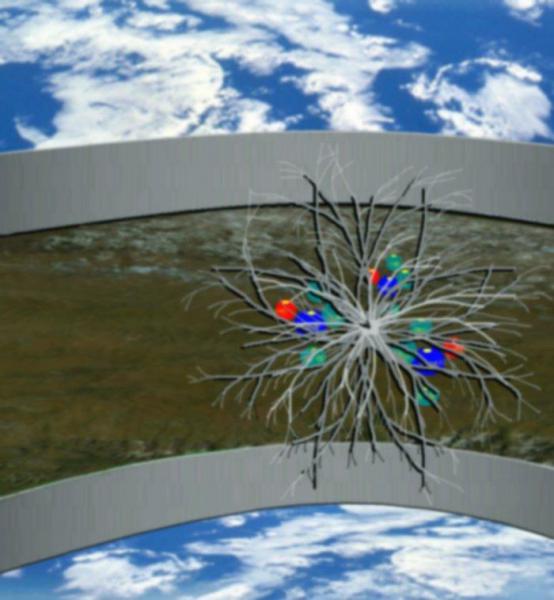BY LETTER
Lifts, The (Kiyoshi)
Technology > Application > Transportation > Atmospheric Transport
Technology > Application > Infrastructure
Technology > Application > Infrastructure
System of artificial airborne 'islands' built on Kiyoshi to commemorate the bimillenial of its construction | |
 Image from Steve Bowers | |
| The Thistledown Lift resembles a giant fractal bush-bot studded with brightly decorated habitable constructs | |
System of artificial airborne 'islands' built on Kiyoshi to commemorate the bimillenial of its construction. Exactly 2000 Lifts were constructed and evenly distributed around the four primary Pentad spheres. Each 'island' is between one and three kilometers across and uses some combination of airship, vacuum dirigible, and reactionless drive technology to support and propel itself up and down the center of one of the thousands of "starwells" that dot the Kiyoshin shells. Each starwell is 10 kilometers across and passes through all the levels of each Pentad component, allowing sunlight to pass from the inner star out into space and the reflector fields in orbit.
Each lift takes approximately two years to complete a cycle of ascent and descent through the ten thousand levels of a Kiyoshin shell. While it travels it forms the center of a vast mobile community of both Oasis and Caravanserai sophonts who either travel aboard the Lift itself, establish temporary communities along the rims of the starwells, or travel in easy proximity to the Lift, either ahead or behind it. Where a Lift travels there are parties and conferences, ceremonies and carnivals. The Lifts are a combination of monument, traveling exhibition, and worlds fair dedicated to the principles of the Kiyoshin way of life. They are considered by both Caravanserai and Oasis citizens to be a ceremonial expression of all that makes them what they are and the unifying principles that make each culture complement the other so well.
Once every century or so, a Lift will reach either the top or bottom of its chosen starwell and make the decision to shift itself to a new location. Traveling along either the innermost or outermost shell of its home component it will use its drive systems to travel to a new starwell where the great cycle of ascension and descent will begin again.
Of the 2000 Lifts created, each was designed not only as a vehicle but as a unique piece of art. The competition to design each of the Lifts for inclusion in the project stretched across the entire MPA and consumed a century in its own right.
A few representative examples of the diversity of Lift designs include:
Thistledown: A great sphere of subdividing manipulator arms ranging from several meters across down to nanometer dimensions. Thistledown is essentially a gigantic bushbot using its trillions of manipulators to provide habitation and support for thousands of sophont beings in an environment not dissimilar from an angelnet.
Erehwon: A converted asteroid, Erehwon supports an island ecology and culture on its upper surface while a vertical ecosystem built around forests of vast hanging vines provides accommodation for various populations of arboreal lifeforms, both sophont and nonsentient.
Rainbow Falls: A swarm of nanotube fabric hot air dirigibles in the tradition of the Pre-Information Age architect Buckminster Fuller. Each component of the swarm is anything up to several hundred meters across and incorporates light-pipes and refractive layers into its outer hull, causing the light that passes through it to break apart into swarms of rainbows both inside the craft and out. Hundreds of small townships and communities inhabit the interiors of the bubble swarms.
Century Rain: A sphere of water some three kilometers across contained by a nanotechnic membrane and supported by a vacuum-cored habitat ring around the equator and an associated halo drive system donated by the Great Architect emself. The interior of the hydrosphere is home to a free-floating marine ecology and several species of aquatic sophont, often including visiting cetacean scholars, speakers, and artists who travel with the Lift for a cycle or two before returning home to their native seas.
Related Articles
Appears in Topics
Development Notes
Text by Todd Drashner
Initially published on 30 December 2006.
Initially published on 30 December 2006.






